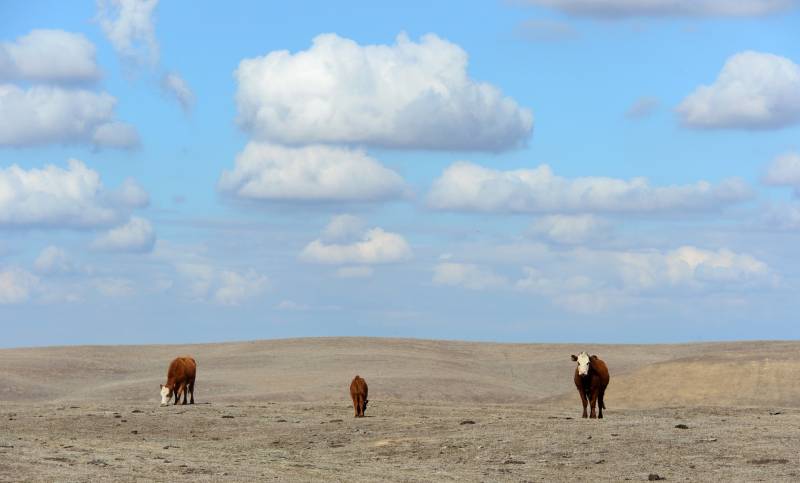“We now have a full, uninterrupted record of soil moisture across western North America that extends from 800 A.D. all the way up to the near present,” said Park Williams, a bioclimatologist at Lamont-Doherty Earth Observatory at Columbia University, who led the study. “That allows us to compare for the first time this drought event to the big megadroughts. And the development of this prolonged drought that began in 2000 looks indistinguishable from those big megadroughts.”
The study looked at California, eight other states and Northern Mexico.
A Worst-Case Scenarios for Water Managers
Scientists have long known that the West suffered in the distant past under anomalous dry periods that lasted for decades.
The region returning to what researchers call a megadrought or a “paleo-drought” is considered to be a worst-case scenario for water managers.
Researchers say the region experienced megadroughts in the 9th, 12th, 13th and16th centuries, disrupting Native American cultures. For example, dry conditions are believed to have driven the Anasazi from their pueblo settlements in Arizona, New Mexico, Colorado and Utah.
One key difference between past and present, Williams says, is that the ancient megadroughts all coincided with long periods of cool water on the ocean surface in the tropical west coast of South America, a natural climate pattern known as La Niña, which contributes to North American droughts.
However, while a mild La Niña and other natural conditions are playing a role in the current drought, Williams says, rising temperatures are responsible for half the severity.
Global warming has driven temperatures in the West up by 2.2 degrees Fahrenheit, he says, and hotter air holds more moisture, absorbing it like a sponge from shrubs, trees and the ground.
“With past megadroughts, we had these naturally occurring dry years, but those dry years were occurring under a completely different backdrop of temperatures,” Williams said. “Where the last 20 years have been substantially warmer than they would have been without global warming, and a warm atmosphere simply can hold more moisture.”
Angeline Pendergrass, a federal scientist with the National Center for Atmospheric Research, who was not involved in the study, agrees that climate change will make droughts worse, she cautions that it may be too soon to know if the region is entering a true megadrought.
But Jay Lund, a professor of civil and environmental engineering at UC Davis and an expert on California’s water supply, said he thinks it’s “quite likely” that warming temperatures could be pushing the region into a prolonged drought.
“If we are going into a megadrought, it would look a lot like this,” he said. “And it would be made even worse with higher temperatures.”
Lund was also not involved in the research.
Megadrought, Meet the Most Populous State in the Nation
A megadrought would have huge and potentially catastrophic implications for California’s 40 million people, many of whom live in parched areas of the state. It would also require continuing ingenuity on the part of water managers who maintain substantial reservoirs at Lake Mead and Lake Powell along the Colorado River.
Under prolonged conditions of drought, populous cities in California would suffer but would likely be able to adapt, Lund says. while farmers and the state’s natural ecosystems would get the worst of it.
“When we do the modeling of these paleo-droughts for California, basically the cities get by okay. They don’t like it. It costs a lot and it hurts,” he said. “But the cities are not affected in their overall prosperity if they’re managed well. It’s agriculture that goes way down, by maybe half. And the ecosystems, they are just sort of in freefall.”
The 20th century saw California grow to be the most populous state in the nation, says Scott Stine, a professor of geography and environmental studies at Cal State East Bay, and that coincided with an especially wet century.
“We built this phenomenal infrastructure, second to none in the world, here in California and in other parts of the West,” he said. “All of it based on the diversion of water and all of it based on the assumption that the 20th century was normal. And the 20th century is not normal.”
“The problem of the present day and the coming droughts is that we are set up to need far more water than we should expect at any time in the coming decades and centuries,” he said. “Particularly with the higher temperatures. We’ve created a monster that we have to continue to feed with water, and the water is just not going to be there.”
Tree Ring Data
The study is based on tree ring data that is painstakingly difficult to obtain, but exceptionally convincing.
To collect tree ring data, scientists first must trudge throughout undisturbed forests and lake beds in search of preserved stumps, which provide a window into soil-moisture levels of the distant past. Williams’ team used records from thousands of trees from across the region. Radiocarbon dating and other techniques on the stumps can determine the age of the tree’s annual growth rings.
In California’s moderate climate, trees grow a single ring each year. In the springtime, after winter rains and snow have soaked the state’s forests, the cells of a tree expand. During the hot summer, they contract.
The expanding and contracting of the cell size is visible in the tree rings. Wet years produce wide rings and dry years thin rings. Researchers can calculate the length of a dry spell by counting the thin rings of a stump.

